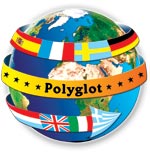It’s not at all unusual to be bilingual. Most of us monoglots know at least one person who knows, speaks and even thinks in more than one language; dyoglots and triaglots (those who speak two and three languages respectively) are common enough to have their own names, and those who speak four languages or more are generally known as polyglots. There are actually adjectives to describe those who speak a certain number of languages all the way up to ten; each has a Latin number prefix:
Speaking 1 language: Monolingual
Speaking 2 languages: Bilingual
3 languages: Trilingual
4: Quadrilingual
5: Pentalingual
6: Hexalingual
7: Septalingual
8: Octolingual
9: Nonalingual
10: Decalingual
But the descriptors seem to end there. Does this mean that humans are incapable of being fluent in more than ten languages? Or simply that such fortunate multi-linguals are too few and far between to deserve their own adjectives? Is it possible to know more languages than we can count on our fingers? Is there a limit to how many languages we can master?
mental_floss explores these questions in an article published today …
How Many Languages is it Possible to Know?

There are millions of people, even in the mostly monolingual US, who speak more than one language at home. Competence in three languages is not unusual, and we’ve all heard stories of grandmas and grandpas who had to master four or five languages on their way from the old country to the new. In India it is common for people to go about their business every day using five or six different languages. But what about 10, 20, 30, 100 languages? What’s the upper limit on the number of languages a person can know?
Find out and read more at mental_floss: http://mentalfloss.com/article/49138/how-many-languages-it-possible-know#sthash.hKE7q7q8.dpuf


Maybe this will help beyond 10 a bit, but for more I would just assume to call them a polyglot.
Undecalingual – 11
Docecalingual – 12
we can just use the same system used to name polygons, if the number of sides is very large, it’s called an “n-gon” with n as a variable for the amount of sides. e.g. 43 sided shape = fourty-threegon, so if someone speaks 43 languages, they are fourty-threelingual.
Hi,
I am writing a graduate paper and part of my research involves bilingualism (trilingualism…. plurilinguism), however as it goes with these papers, you need to cite everything and have a reference. It might be hard to believe but it is difficult to find a real scientific paper where a definition and difference between a bilingual and a plurilingual is described. Most authors just use bilingualism for people who speak more than 2 languages. But it is not clearly stated, so I have a problem with referencing.
So, could you please post the web site where you got this information? I can search from there maybe I finally find something.
Thank you
Thanks for your comment, Iris,
If you check the definitions of all those words in any reputable dictionary (I tend to use the Oxford English Dictionary), you’ll find precise and exact definitions. Taking the two examples you cite, “bilingual” means “speaking two languages fluently” and “plurilingual” means “relating to, involving, or fluent in a number of languages; multilingual.” The Oxford English Dictionary (and other respectable dictionaries) can surely be cited as legitimate reference sources.
I hope that helps!
Louise
Hi Iris,
Thanks for your comment. You can find precise and legitimate definitions of any of those words in any reputable dictionary. Taking the two examples you cite, “bilingual” (according to the Oxford English Dictionary) is defined as “speaking two languages fluently”, and “plurilingual” means “relating to, involving, or fluent in a number of languages; multilingual.” I’m sure that a good reputable dictionary such as the OED should be perfectly acceptable to cite as a legitimate reference source.
I hope that helps!
Louise
Hi,
Sorry to be nitpicky,m but it seems like either this article isn’t telling the full story, or another one of my sources is wrong. I came across this before coming across your article:
http://mathforum.org/library/drmath/view/57196.html
Note that if you compare what is said in the above article with what the link says, something doesn’t add up. The prefixes start off with Greek for mono-, then switch right into Latin for 2-5 (granted, 3 is the same for both so that could be either or really) before hopping right back into Greek without missing a beat for a single one, and then switching right back into Latin for 7 and 9 (with 8 and 10 being overlaps like 3).
Could someone clarify why this is or if the source of information I posted is wrong? Citations would be greatly appreciated.
Thanks in advance,
Sebry
Pingback: De basis van meertaligheid | | Donders Wonders